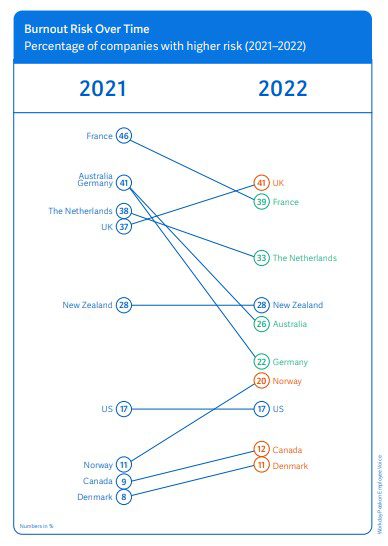It’s time to address the causes of burnout
Not just the symptoms.
Why You Should Care
Employees are stressed and burnt out.
Here's some advice from Workday on how to spot the risks of burnout.
And how to deal with burnout before it becomes a crisis.
2022 was the worst year on record for burnout.
Of course, burnout doesn’t happen overnight – it is the result of extreme stress and overwhelm over a prolonged period. Therefore, it is no surprise that the world is in a burnout crisis now given that employees have experienced severe disruption to their lives since the COVID-19 pandemic began in early 2020.
As a result of these extreme and growing pressures on the workforce, HR tech giant Workday decided to explore the concept of burnout risk (aka warning signs that employees are on the verge of burnout).
Using anonymized data from 1.5 million employees from 600 companies globally, Workday identified three factors that contribute to higher risk of burnout – energy, connectedness and fulfillment.
Essentially, when employees aren’t energized or motivated, feel no connection to their workplace or don’t feel they are doing meaningful work, then they are at a higher risk of burnout, which is bad for company bottom lines and retention.
Inside the data on burnout risk
Workday’s data showed that like burnout, burnout risk has been on the rise in 2022.
Of the ten global industries measured, seven maintained or saw an increase in burnout risk in the last year. The biggest increases were in the transport sector (16%), government (10%) and healthcare and non-profits (4%).

Credit: Workday report, Addressing Employee Burnout Risk in 2022.
This means only three sectors saw a decline in burnout risk in 2022 – these were manufacturing, professional and business services, and financial services.
While financial services has been performing well in three metrics for burnout risk, the other two industries were struggling in the area of fulfillment. Employees may be energized and connected to one another, but there is a risk of burnout because of workers’ lack of meaningful work.
In terms of regional differences, the UK and Norway saw the largest increases in burnout risk (9% and 4% respectively). In fact, the UK’s burnout risk was the highest of all countries in 2022 with 41%, closely followed by France on 39%.
Workday’s report found that France, the UK and New Zealand (28%) were underperforming on the three metrics – energy, connection and fulfillment – as was Germany (22%).
It’s not all doom and gloom as the US, Denmark and Canada were doing well across all three factors– and they had 17%, 11% and 12% burnout risk respectively.

Credit: Workday report, Addressing Employee Burnout Risk in 2022.
How to nip burnout in the bud
There are lots of lessons to learn from countries and sectors that are performing well – but what are the steps that organizations must take to ensure that their workforce is energized and motivated, feels a sense of connection to their workplace and sees their work as fulfilling and meaningful?
Workday’s general vice-president for Northern Europe and South Africa Michael Douroux tells UNLEASH: “Whilst there is no set rulebook for stopping burnout, there are several key ways in which businesses can help employees with stress.
“These must be done at an organizational level to promote a compassionate culture, while also enabling people leaders to solve problems and giving employees a shared sense of purpose.”
In the report, Workday shares some concrete recommendations for employers. These include recognizing and responding to early signs of stress, fostering a culture of transparency around wellbeing and mental health by encouraging employees to share stories, and leaning into recognition and appreciation both top down and peer-to-peer.
Other examples include encouraging cross-team collaboration via mentorship or partnership opportunities so employees can see that their work is meaningful, embracing flexibility around where and when people work particularly in relation to medical appointments and caregiving responsibilities.
However, Douroux is clear: “Managing burnout requires a measurable and data-driven approach. Employee listening and pulse survey tools help HR leaders to measure employee sentiment (through AI and data analytics) to deliver insights.
“If this is done on a continuous basis, organizations can easily carry out measurement of employee sentiment on a regular basis.
“This will allow organizations to identify employees who may be at risk of burnout and establish next steps to remedy the situation.”
Some food for thought for organizations if they want to avoid 2023 being a year of burnout, and instead transform it into the year of engaged and productive employees.
The International Festival of HR is back! Discover amazing speakers at UNLEASH America on 26-27 April 2023.
Sign up to the UNLEASH Newsletter
Get the Editor’s picks of the week delivered straight to your inbox!

Chief Reporter
Allie is an award-winning business journalist and can be reached at alexandra@unleash.ai.
